Whether it’s snakes in the Sahara Desert or snakes in your backyard, they are one of the most intimidating creatures on the planet. This is despite their small size (in general). Here, in the U.S., one of the most dangerous snakes is the copperhead, simply because of the sheer number of people it bites each year.
However, on a bad day, a bite from a copperhead may require more than moderate treatment at the hospital. Some snakes on this list are the most dangerous in the world. Some are quite benign. No matter how frightening, snakes are endlessly fascinating creatures, and those that live in the Sahara Desert are even more so.
It’s the largest “hot” desert in the world and though deserts are often thought of as dead places, it’s full of a variety of wildlife. This includes snakes, some of which are well-known and some that are more obscure in the everyday lexicon. Among the sands that cover 5,716,614 mi² (9,199,998.44 km²), are a handful of snake species, thriving under the hot sun, and they are both fascinating and terrifying!
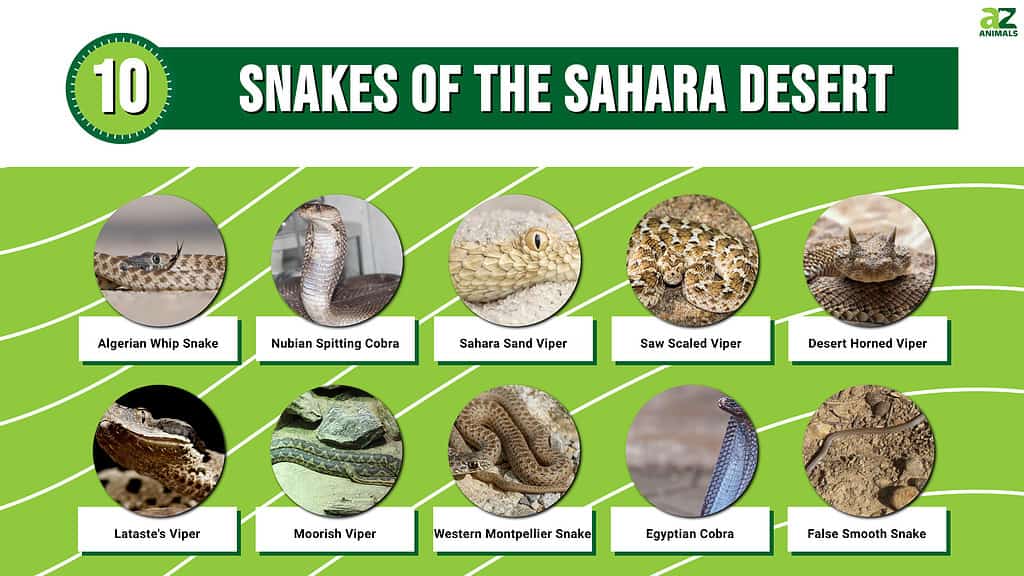
How Do Snakes Survive In The Desert?
Snakes in the Sahara Desert live in a harsh but ideal environment. Unlike many assumptions to the contrary, the Sahara desert is teeming with life. Though it’s an arid environment, there are a score of lakes there, including the freshwater Lake Chad. There are also over two million people living throughout what is seemingly a bleak landscape.
Underneath the dust-swept rocks and endless dunes, however, is a world of species that include mammals, reptiles, amphibians, fish, birds, and people. A snake can survive in the desert because the menu is more palatable than appearances indicate. There is plenty for them to eat. Snakes have to work for it a little harder, unlike a python in the Everglades, but the prey is plentiful, nonetheless.

Umm al-Ma Lake – Idyllic oasis in the Awbari Sand Sea, Sahara Desert, Libya
©Patrick Poendl/iStock via Getty Images
Some of the animals that may find themselves on a Sahara snake’s menu include mongoose, weasels, a variety of birds, frogs, skinks, a variety of lizards, toads, and gerbils, just to name a few. Animals are nothing if not followers of patterns, and the largest hot desert in the world features seasonal patterns, as well as more than one type of ecosphere.
It even rains in the Sahara. It’s a measly three inches a year, but it does happen throughout certain regions. The thing is, the Sahara Desert is so large that there is more to it than just the immediate visualization of endless, dry, and cracked earth, or dunes.
While some snakes on our list are fairly docile, at least in the unexpected presence of humans, others are incredibly dangerous. This list even includes a snake species that is responsible for killing more people than any other snake in the world. They survive in this harsh environment because they are so well suited for doing so, including the never-ending pursuit of prey.
1. Algerian Whip Snake
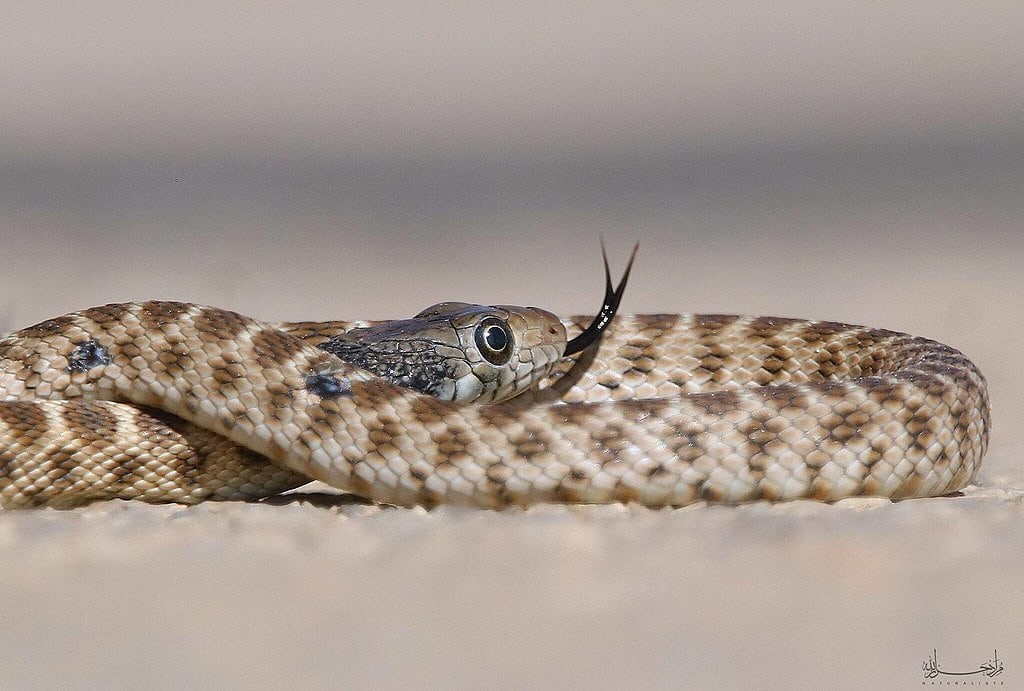
The Algerian whip snake coiled and flicking its long, black tongue.
©mourad-harzallah, CC BY 4.0 , via Wikimedia Commons – License
The first in our list of snakes in the Sahara Desert is the Algerian whip snake (hemorrhois algirus). While this snake is native to North Africa, it’s also become naturalized in Malta, thanks to human interference. The Algerian whip snake features light brown to black bands against a cream or tan background. The bands are not complete and are broken up (like half-circles) in patterns across the body.
As a non-venomous snake, the Algerian whip snake is a constrictor, capturing and wrapping around its prey, squeezing the life out of them. An adult will reach anywhere between 28″ and 55″ in length, and they prefer to make their lairs beneath the hot earth of the Sahara.
2. Nubian Spitting Cobra
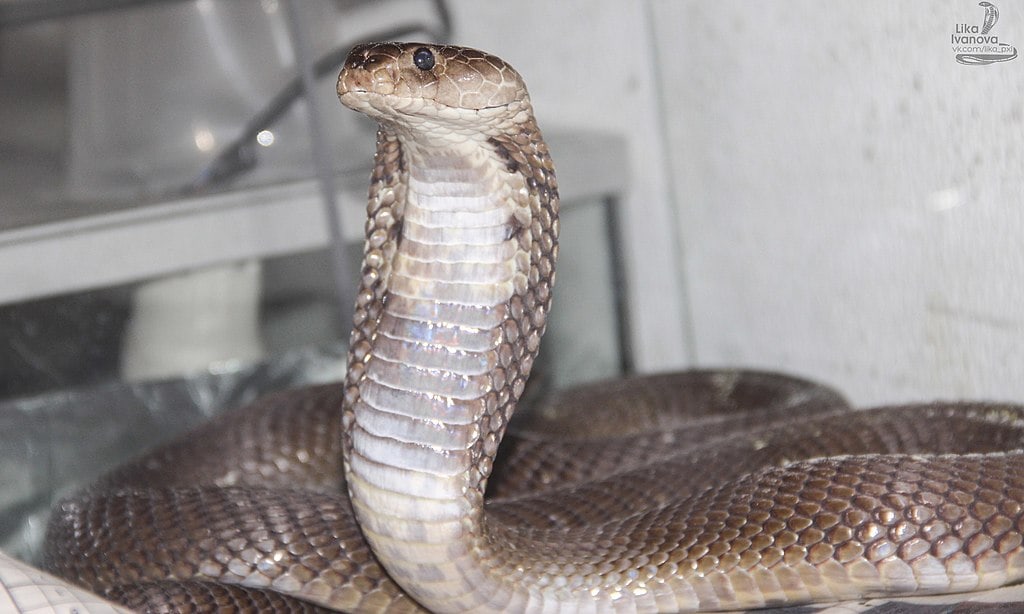
The Nubian spitting cobra is upright and in a curious, semi-striking pose.
©Лика Иванова (Lika Ivanova), Public domain, via Wikimedia Commons – License
The Nubian spitting cobra (Naja nubiae) is one of a select few “spitting cobras” throughout the world. Their name is well-earned, with the double threat of both spitting venom (they aim for the eyes) and injecting it via their sharp fangs. This “spit” is a combination of neurotoxin and cytotoxin, neither of which you want to be on the receiving end of.
It’s less a matter of ‘spitting’ and more a matter of ejecting venom from their fangs at a high rate of speed. Scientists believe that spitting cobras developed this mechanism as a defensive response to stampeding herds of gazelles.
3. Sahara Sand Viper
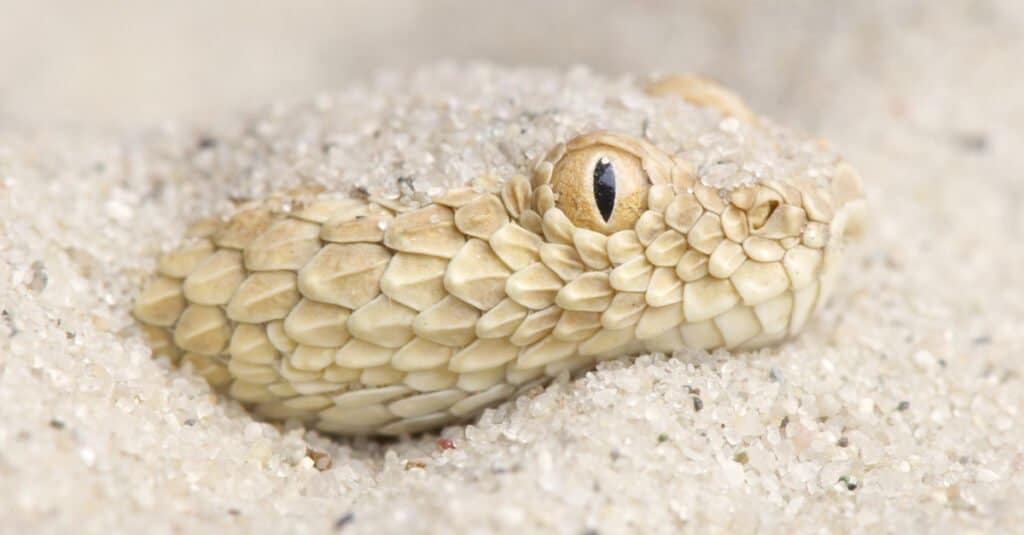
The color of the sand viper helps it to blend in with its habitat where it hunts for prey.
©reptiles4all/Shutterstock.com
The Sahara Sand Viper (Cerastes vipera) is a crafty snake, often burying itself beneath the sands with only its head protruding, waiting for a small animal with the worst luck in the world to come traipsing by. They’re surprisingly small vipers, with fully grown adults only reaching 8″ to 14″ in length.
However, though they are known for waiting in ambush, sand vipers are also active hunters when they feel the urge. They are equipped with the best of both worlds, in terms of hunting strategies, making the Sahara sand viper one of the most dangerous snakes in the Sahara Desert.
4. Saw Scaled Viper
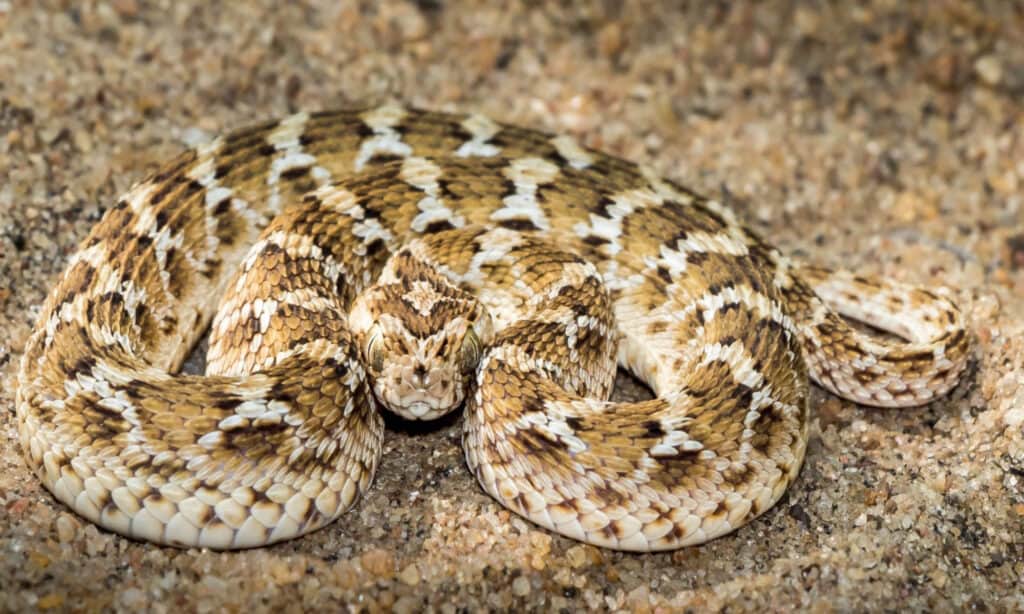
This adaptable snake lives in a variety of habitats.
©Dushan Muthunayake/Shutterstock.com
The saw-scaled viper (E. leucogaster, E. pyramidum) is officially the deadliest snake in the world. It didn’t achieve that label because it has the most potent venom (it doesn’t) or because it’s extremely large (it isn’t). It earned its nefarious reputation because it simply comes into more deadly contact with human beings than any other snake.
Like a rattlesnake, the saw-scaled viper gives off a warning on approach by rubbing its scales together to create a sinister hissing sound. It may not be as loud as a rattle, but it’s audible. Unfortunately, it’s a very aggressive snake with a bite-first mentality. Though its venom only kills in less than 10% of all cases, it bites so many that the death toll is huge.
5. Desert Horned Viper
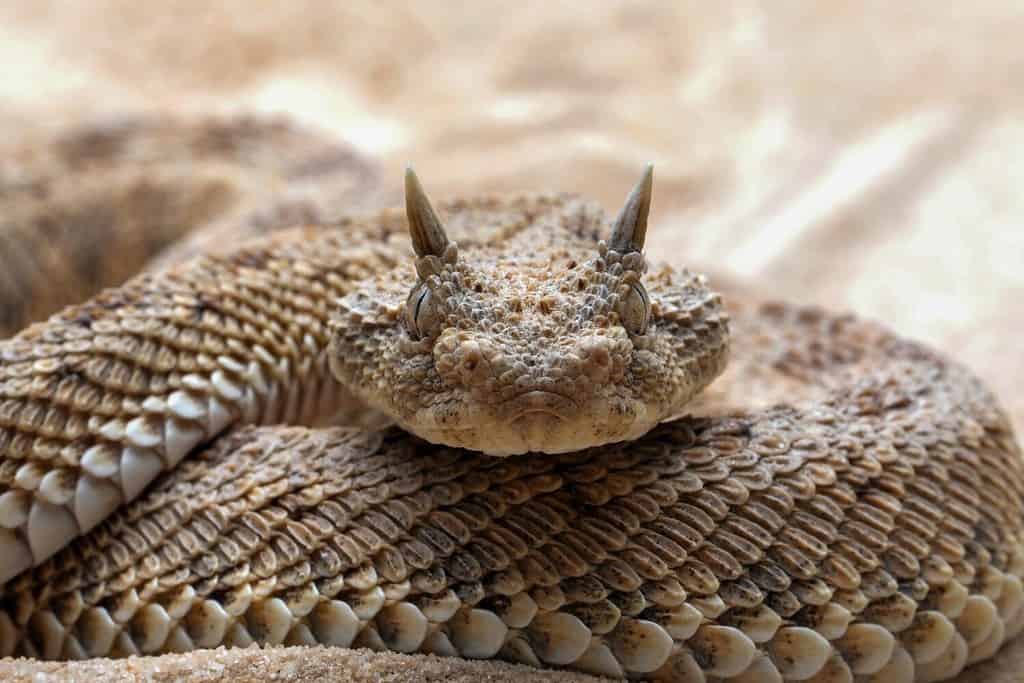
The desert horned viper’s unique, horn-like protrusions make it a rare and fascinating species of snake throughout the world.
©Lauren Suryanata/Shutterstock.com
The desert horned viper (Cerastes cerastes) is almost mythical, reminiscent of desert devils and ancient, insidious beings from tales written in bygone eras. It’s the perfect match for snakes in the Sahara Desert; the quintessential snake of terrifying fables come to life. The reality is, that they’re a lot smaller than the imagination wants to credit them, with adults reaching 12″ to 24″ in length.
Their namesake comes from the horn projections, jutting out above each eye. One bright spot, in terms of human beings remaining wary of this particular predator, is that they are instantly recognizable. Even though the horns are small, the characteristic is pronounced enough that the snake is identifiable at a distance.
6. Lataste’s Viper
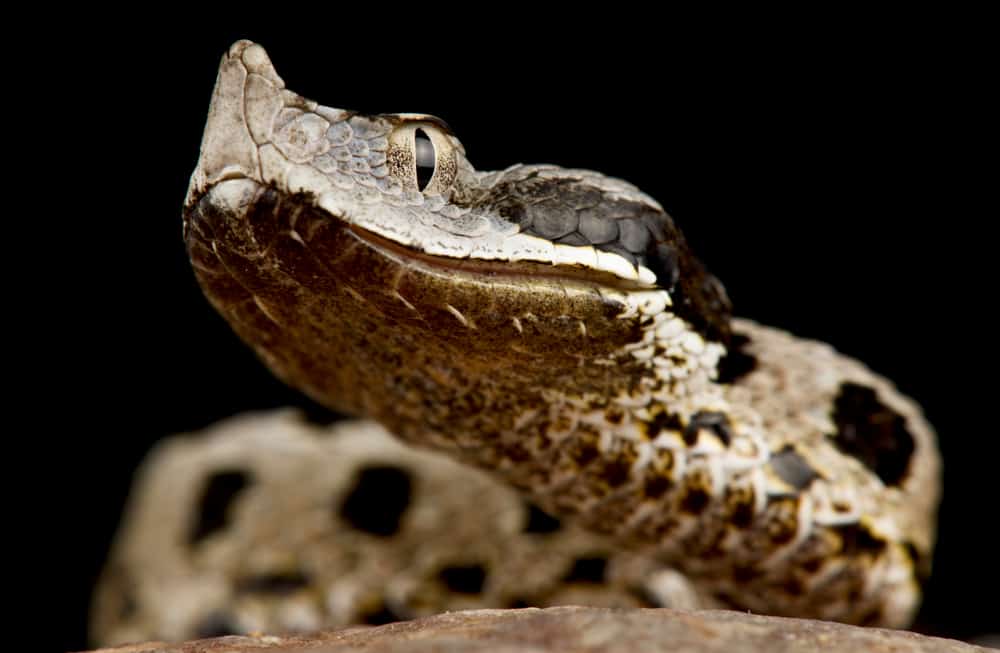
The Lataste’s Viper (
Vipera latastei)
©reptiles4all/Shutterstock.com
Lataste’s Viper (Vipera latastei)is yet another viper on our list of snakes in the Sahara Desert. It almost sounds like vipers are the dominant species of the Sahara. They grow up to a length of 28″, with only a small variation from viper to viper.
It’s a highly recognizable snake, thanks to the upturned protrusion on the tip of its snout. It’s also a very rare snake. You could travel the sands and sweeping, rocky vistas of the Sahara a thousand times and never encounter one. This is due to their solitary nature, often remaining alone for nearly their entire life cycle.
7. Moorish Viper
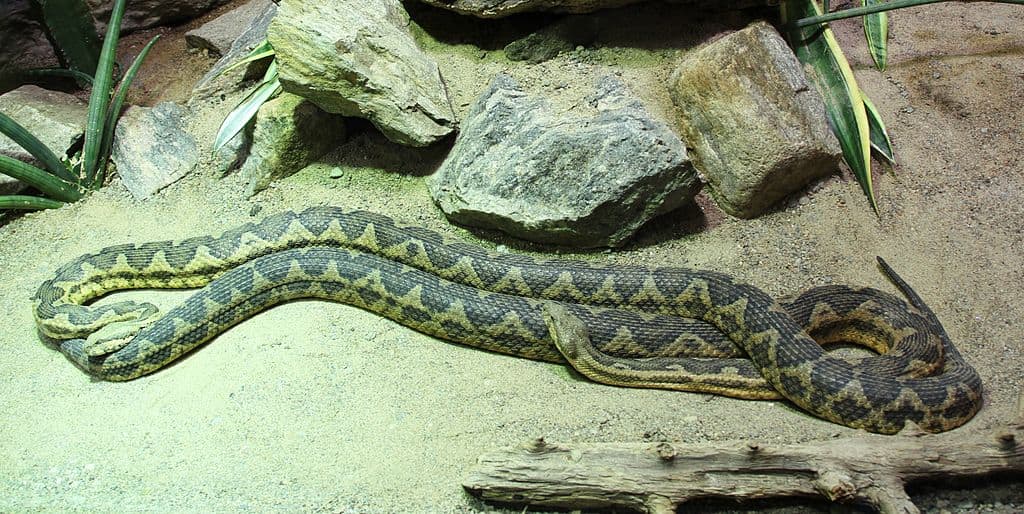
The Moorish viper is on the ‘near-threatened’ species list with a marked, 30% reduction over the years.
©Bjoertvedt, CC BY-SA 3.0 , via Wikimedia Commons – License
The Moorish viper (Macrovipera mauritanica) is also known as the Sahara rock viper and the atlas blunt-nosed viper. It’s a particularly long snake, reaching up to 70″ as an adult. Unfortunately, the Moorish viper is classified as a “Near Threatened” species, according to the IUCN (International Union for Conservation of Nature).
As a venomous viper, it is typically harvested for its venom, along with humans killing them on sight. Its diamond-shaped head is typical of a viper, and its rounded diamond patterns of brown and black, set against a background of yellow-green, make it easy to identify.
8. Western Montpellier Snake
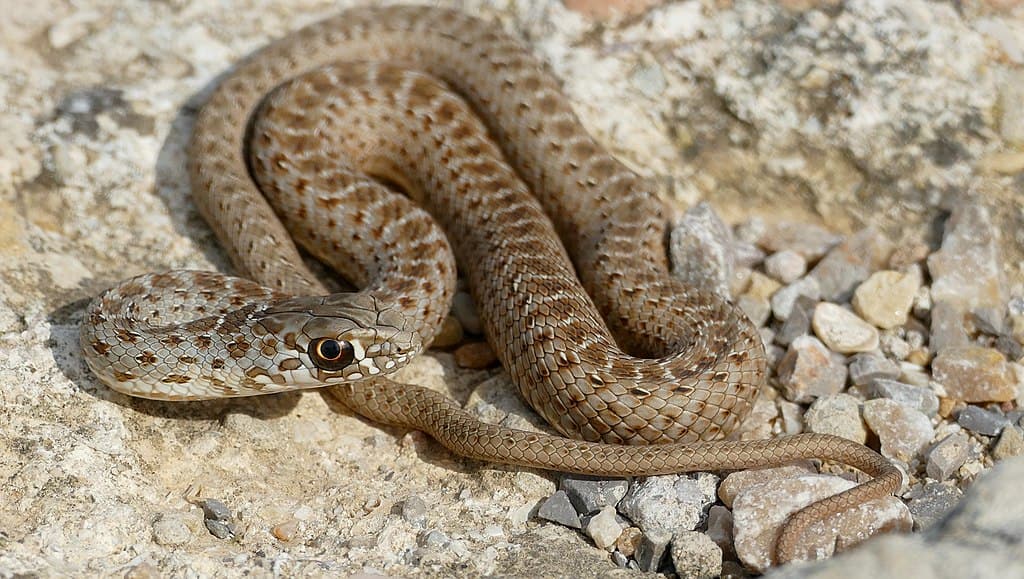
The western Montpellier snake is very common in the Sahara Desert.
©Bernard DUPONT from FRANCE, CC BY-SA 2.0 , via Wikimedia Commons – License
The western Montpellier snake (Malpolon monspessulanus) is very common in Northwest Africa, Portugal, the coast of France, the Middle East, and Spain. It’s a venomous snake, though it’s one of the few, non-viper snakes on our list of snakes in the Sahara desert.
Despite how common it is, it rarely bites humans and is far down on the list of attacks. Its poison is also rather weak. Its low attack rate and weak venom largely contribute to the snake’s expansion as a species, since humans are not highly concerned with them.
9. Egyptian Cobra
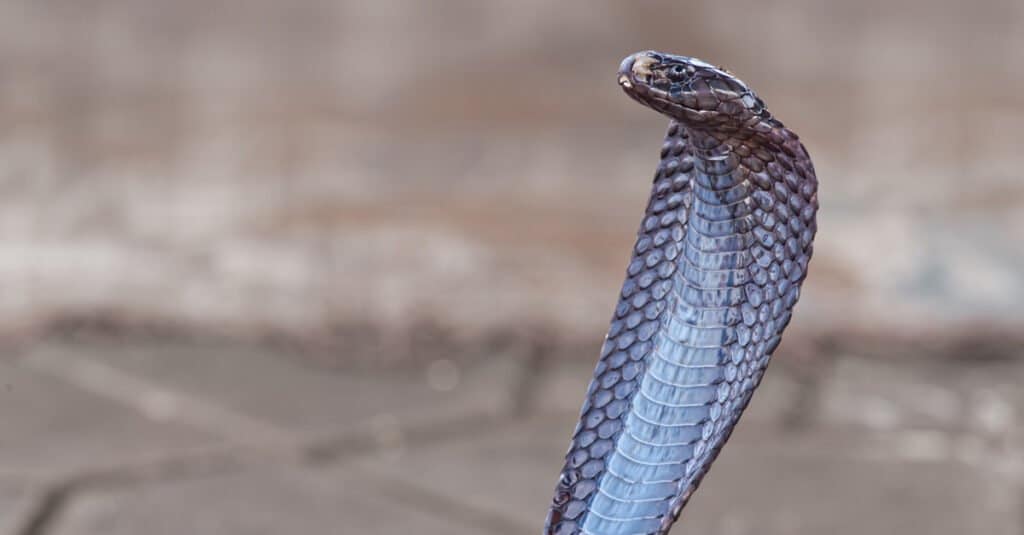
The Egyptian cobra is either brown, black, or banded with both colors.
©OPIS Zagreb/Shutterstock.com
The Egyptian cobra (Naja haje) is one of many cobra species. The tell-tale hood that makes cobras so famous (or infamous, if you will), is present, along with a very large body. 4.6′ is the average length of an adult. It’s also a well-rounded snake that’s thick from head to tail. One thing is for certain, its size makes it easy to spot.
Despite most pictures and drawings of the Egyptian cobra representing it in black or very dark color, they are highly variable in coloration. The Egyptian cobra is a very large and intimidating snake with a potent neurotoxin and cytotoxic venom.
10. False Smooth Snake
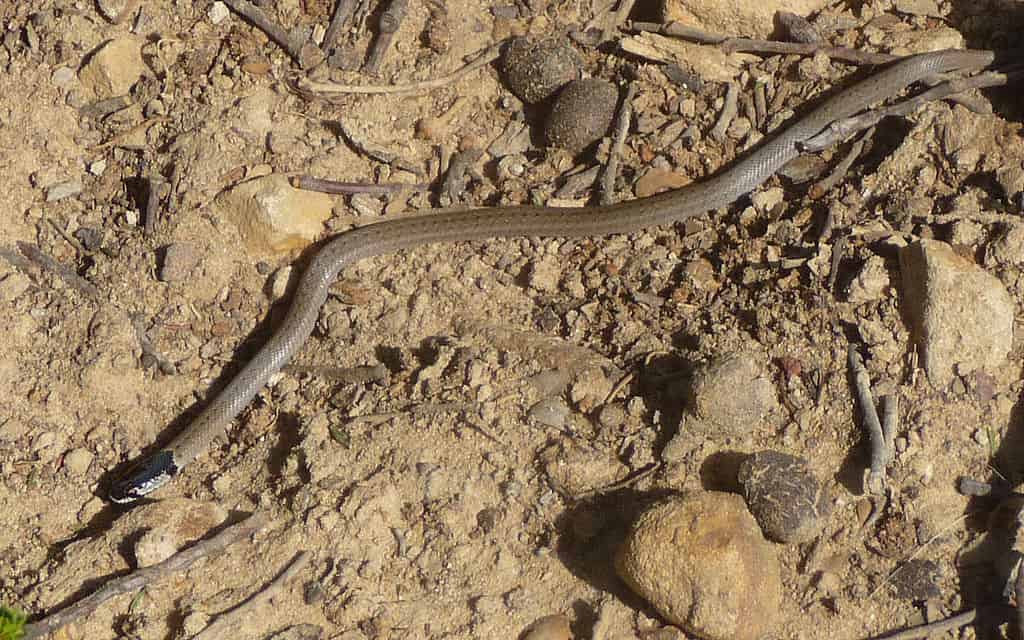
©gailhampshire, CC BY 2.0 , via Wikimedia Commons – License
Last, but not least, we have the false smooth snake (Macroprotodon cucullatus). It’s a relatively small snake, in terms of body size and length (21″), so it primarily feeds on small mice, a variety of small lizards and salamanders, baby birds still in the nest, and small frogs.
In the Sahara desert, the False Smooth Snake is primarily nocturnal, though it is diurnal in other parts of the world. It is also a venomous snake, injecting its poison using grooved teeth. However, it’s a mild toxin and not very dangerous to human beings.
Final Thoughts
Snakes in the Sahara Desert are not exactly few and far between. Despite one of the snakes on our list existing on a nearly threatened list, snakes are abundant throughout the massive Sahara. Like all snakes, they adapt to their environment, finding new ways to hunt prey, seek shelter, and breed.
While some of these are terrifying snakes, especially in real life, they are endlessly fascinating creatures. Each has their habits and even a degree of persona, depending on their experiences surviving in the harsh and arid climate.
The photo featured at the top of this post is © skander zarrad/ via Getty Images
Discover the "Monster" Snake 5X Bigger than an Anaconda
Every day A-Z Animals sends out some of the most incredible facts in the world from our free newsletter. Want to discover the 10 most beautiful snakes in the world, a "snake island" where you're never more than 3 feet from danger, or a "monster" snake 5X larger than an anaconda? Then sign up right now and you'll start receiving our daily newsletter absolutely free.
Thank you for reading! Have some feedback for us? Contact the AZ Animals editorial team.






